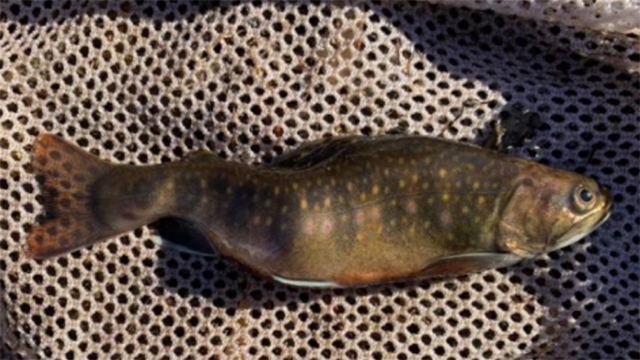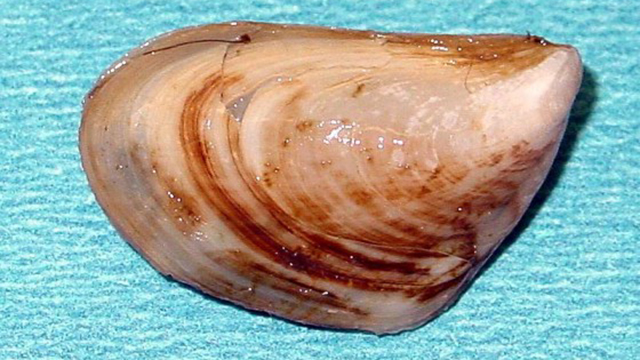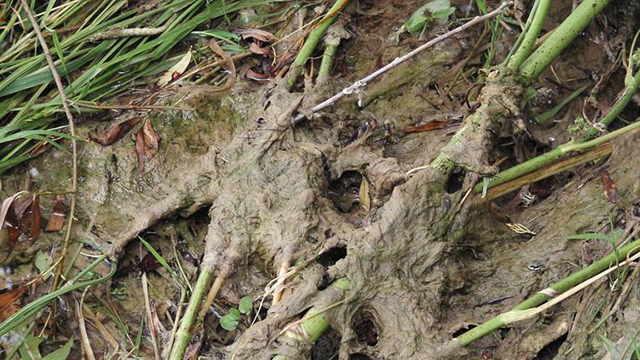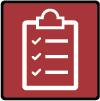
Water activity rules and regulations
Banff National Park
What are Aquatic Invasive Species?
Aquatic invasive species (AIS) are non-native plants, animals, and diseases. Many AIS are harmful to freshwater ecosystems. AIS reproduce quickly, rarely have natural predators and often out-compete native freshwater species. Preventing aquatic invasive species from entering waterways is a Parks Canada priority. Once AIS are established, removal is next to impossible.
-
Whirling Disease
Whirling disease is caused by a parasite that causes skeletal deformities of an infected fish’s body or head, usually in young fish, and the tail may appear dark or black. The disease can be spread to other waterbodies through spores in mud. This disease is not harmful to humans or other mammals but can have significant effects on some fish populations, such as Westslope cutthroat trout.

-
Invasive mussels
Quagga and Zebra mussels are small, fan-shaped, and range from dark brown to white in colour. Just a few mussels can produce millions of eggs. They are very efficient at filtering nutrients from the water, leaving no food for native species. Dense colonies of mussels can clog water pipes and make the shoreline unusable because of their sharp shells and odour.

Photo credit: invasive.org -
Eurasian water milfoil
Eurasian water milfoil is a perennial, submersed aquatic plant native to Eurasia and North Africa. Although not currently present in Alberta, new colonies can form from a single stem, seed or leaf. Eurasian milfoil forms thick layers that shade native plants and decrease oxygen levels as they decay.

Photo credit: invasive.org -
Didymo
Didymo is a freshwater algae that has the appearance of wet toilet paper and the feel of wet cotton wool. It attaches to rocks in streams and can form into large beige to brown mats that completely cover the stream bottom, blanketing important fish and plant habitat.
Felt-soled wading boots (banned in mountain national parks) and other water gear are a common way for didymo to spread.
Photo credit: invasive.org
Clean, drain, dry, and certify all watercraft and water-related gear before entering a new waterbody to prevent the spread of Aquatic Invasive Species

Clean
all mud, sand, plant, and animal materials from your watercraft, gear, and angling equipment.

Drain
all watercraft, gear, and angling equipment before leaving the waterbody.

Dry
for at least 48 hours when last used within AB, BC, NWT, or YT; and at least 30 days when last used outside of AB, BC, NWT, or YT.

Certify
watercraft, gear, and angling equipment by visiting a Parks Canada inspection station or obtaining a self-certification permit.
How to certify at Banff National Park
Inspection requirements for motorized watercrafts
You must obtain a Parks Canada AIS prevention inspection permit at the Lake Minnewanka inspection station, located 6 km from the town of Banff along the Minnewanka Loop Road. Hours of operation.
Lake Minnewanka is the only waterbody in Banff National Park where boats with motors, both gas and electric, are allowed. There is an unloading ramp and parking area for boats and trailers. There are no public boat docks in the park.
How to certify your motorized watercraft (gas and electric motors)
- Visit the Lake Minnewanka Inspection Station prior to launching on Lake Minnewanka.
- At the inspection station:
- Trained staff will inspect watercraft and gear for AIS, standing water, and mud.
- If required, staff will clean equipment with warm water.
- At their discretion, staff will issue Proof of Inspection permits to keep with you on the water and to display in your vehicle windshield.
Inspection requirements for non-motorized watercrafts and water recreational gear
Anyone launching non-motorized watercraft such as canoes, kayaks, paddleboards, inflatables, and water-related gear are required to complete an AIS prevention self-certification or inspection permit every time you enter a new lake, river or stream in Banff National Park.
How to certify your non-motorized watercraft (paddleboards, canoes, kayaks, inflatables, etc.)
- Obtain an AIS prevention self-certification permit from:
- Self-certification stations at waterbody access points and trailheads
- Visitor centers and campgrounds
- Online
- Inspect your watercraft to ensure it is clean, drained, and dried. All equipment must be dried for:
- 48 hours if last used within AB, BC, NWT, or YT and when switching waterbodies within the park.
- 30 days if last used outside of AB, BC, NWT, or YT.
- Fill out the self-certification permit. Keep the top portion with you while you recreate. Deposit the bottom portion in the self-certification permit box.
- If your watercraft is not clean, drained, and dry or does not meet the dry time requirements, you must visit a Parks Canada inspection station prior to entering park waters.
- At the inspection station:
- Trained staff inspect watercraft and gear for AIS, standing water, and mud.
- If required, staff will clean equipment with warm water.
- At their discretion, staff will issue a Proof of Inspection permit to keep with you while you recreate.
- When switching waterbodies: Clean, Drain, and Dry watercraft for 48 hours, then obtain a new self-certification permit; OR visit a Parks Canada Inspection Station.
Inspection stations are located at:
- Lake Minnewanka Inspection Station: Located along the Minnewanka Loop Road, approximately 6 km northeast from the town of Banff.
- Lake Louise Inspection Station: Located in the Lake Louise overflow parking lot approximately 7 km southeast from the town of Lake Louise on Highway 1.
How to certify your water-related gear (angling equipment, scuba gear, snorkelling gear, etc.)
- Obtain an AIS prevention self-certification permit from:
- Self-certification stations at waterbody access points and trailheads
- Visitor centers and campgrounds
- Online
- Inspect your equipment to ensure it is clean, drained, and dried. All equipment must be dried for:
- 48 hours if last used within AB, BC, NWT, or YT and when switching waterbodies within the park.
- 30 days if last used outside of AB, BC, NWT, or YT.
- Fill out the self-certification permit. Keep the top portion with you while you recreate. Deposit the bottom portion in the self-certification permit box.
- If your equipment is not clean, drained, and dry or does not meet the dry time requirements, you must visit a Parks Canada inspection station prior to entering park waters.
- At the inspection station:
- Trained staff inspect equipment for AIS, standing water, and mud.
- If required, staff will clean equipment with warm water.
- At their discretion, staff will issue a Proof of Inspection permit to keep with you while you recreate.
- When switching waterbodies: Clean, Drain, and Dry equipment for 48 hours, then obtain a new self-certification permit; OR visit a Parks Canada Inspection Station.
Inspection stations are located at:
- Lake Minnewanka Inspection Station: Located along the Minnewanka Loop Road, approximately 6 km northeast from the town of Banff.
- Lake Louise Inspection Station: Located in the Lake Louise overflow parking lot approximately 7 km southeast from the town of Lake Louise on Highway 1.
If you are unable to meet the Clean Drain Dry requirements indicated on the AIS Prevention Self-certification Permit, you are prohibited from launching a watercraft in Banff National Park until the permit conditions are met, or your watercraft or water-related gear have been inspected at a Parks Canada watercraft inspection station.
Going fishing? Learn more about fishing regulations in Banff National Park
Where to certify in Banff National Park
Locations details
Watercraft inspection stations
|
| Banff Visitor Centres |
| Lake Louise Visitor Centre |
| Two Jack Lakeside |
| Cascade Ponds |
| Johnson Lake |
| Lake Minnewanka Boat Dock |
| The Bow River - 5 Mile, Bow Falls, Town of Banff Recreation Grounds |
| Two Jack Lake |
Inspection stations
Watercraft inspections are available at the Lake Minnewanka inspection stations by appointment between October 1, 2024 – Spring 2025.
Appointments must be booked 48 hours in advance.
How to book your inspection by appointment
Inspections can be booked by email or by calling and leaving a message.
For inspections by appointment at the Lake Minnewanka inspection station (motorized and non-motorized watercraft):
bfuaisprevention-eaeprevention@pc.gc.ca
(403) 497- 5821
Please include the following information:
- Your name and contact information.
- Date of launch.
- Time you would like to have your watercraft inspected.
- Type of watercraft (fishing boat, jon boat, cabin cruiser, pleasure craft, inflatable).
- Propulsion type (outboard, inboard, inboard outboard, trolling, jet, sterndrive).
Please ensure that your watercraft is CLEAN, DRAIN, DRY.
When entering any new waterbody within Banff National Park, users of watercraft and water-related gear must obtain a new AIS Prevention Permit. If you are unable to meet the Clean, Drain, Dry requirements indicated on the AIS Prevention Self-certification Permit, you are prohibited from launching a watercraft in Banff National Park until the permit conditions are met, or your watercraft or water-related gear have been inspected at a Parks Canada watercraft inspection station.
How to: Clean, Drain, and Dry | Parks Canada
Transcript
[This video has no spoken language. Text appears on screen throughout the video.]
[Sounds of water and calm guitar music throughout the video.]
[Two people paddling a canoe; Parks Canada beaver logo appears.]
Text: Exploring Parks Canada’s lakes, streams and rivers is a popular way to see the national parks.
[Aerial view of large blue lake.]
Text: Yet these water bodies are vulnerable to aquatic invasive species.
[Two people paddling a canoe, paddleboarder behind them, on a lake.]
Text: These invaders can hitch a ride on watercraft like kayaks, inflatables and SUPs.
[Canoers and paddleboarder arrive to shore.]
[Images shown of zebra mussels and shelled invasive species.]
Text: Aquatic invasive species, once established, irreversibly damage ecosystems and harm species at risk.
[Canoers and paddleboarder arrive on shore.]
[The words “CLEAN DRAIN DRY” are written in mud on the back of a canoe. Water is slowly poured overtop and washes it away.]
[Canoers pull canoe onto shore.]
Text: Clean, Drain, Dry your watercraft and gear BEFORE and AFTER entering the water.
Large title on screen: Step 1: Clean
[Two people clean a canoe. A jug scoops water from a lake.]
[View from inside a canoe; water is poured onto the side of a canoe while a cloth wipes it down.]
Text: Clean all debris from your watercraft and water-related gear BEFORE and AFTER your trip.
[A paddleboard is wiped down with water and a cloth.]
[Two people pour water and wipe down the backside of a paddleboard.]
Large title on screen: Step 2: Drain
[Two people tip a canoe onto its side; water is emptied from a canoe on its side.]
Text: Drain coolers, buckets, compartments and other items that may hold water on land before leaving the waterbody.
[A paddle is pulled apart and emptied of water.]
Text: Some aquatic invasive species can survive in pools of water for 30 days.
[Two people stand a paddleboard up against a tree.]
Large title on screen: Step 3: Dry
[Two people wipe down the backside of a paddleboard. A close-up shows a hand wiping down a paddleboard with a cloth.]
Text: Use a clean towel to wipe down the entire watercraft. Set aside to dry.
[Two people wipe down a paddleboard with cloths.]
Text: Ensure items are completely dry before entering a new lake, stream or river.
[A close up of a paddleboard with water on it.]
[Two people walking through a forest, one person holding a paddleboard and another with PFD.]
[A person rolls a deflated paddleboard and wipes it down with a cloth as they roll it.]
[Two people pack a paddleboard into a bag.]
[A lake with two people paddling a canoe, and two people standing on paddleboards.]
Text: Sustainable aquatic ecosystems are vital to the overall health of Canada’s lakes, streams and rivers.
Text: Do your part to protect park waters: Clean, Drain, Dry.
[Logo] Parks Canada, Parcs Canada.
[Logo] Canada
Report aquatic invasive species sightings
Take a picture, note the location, and send it to ReportAIS-SignalerEAE@pc.gc.ca
Sightings outside of the national parks can be reported to:
1-855-336-2628 (BOAT) in Alberta and 1-888-933-3722 in British Columbia.
Related links
- Date modified :